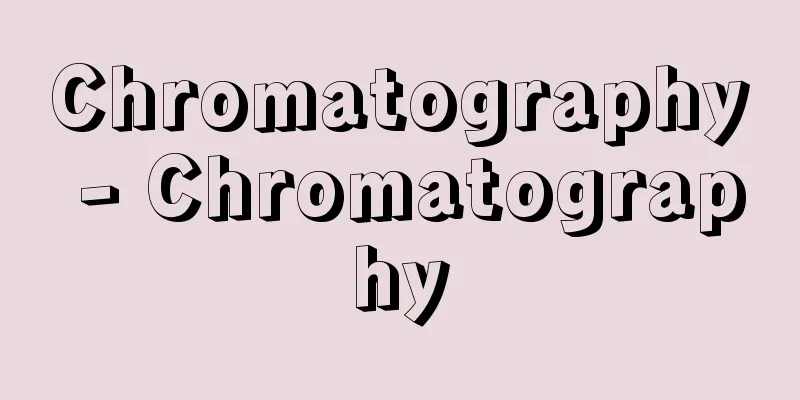Chromatography - Chromatography

|
A method of separation and quantification of mixtures by utilizing differences in behavior between chemical species at the interface between different phases, i.e. differences in adsorption capacity, distribution coefficient, volatility, ion exchange capacity, molecular size, etc. There are various types of chromatography, as described below, but the principle is the same in all cases. A sample is introduced at one end of a fixed adsorbent (called the stationary phase), and a solvent or gas is continuously passed through it (called the mobile phase). The mobile phase dissolves the sample from the stationary phase, but when the solute slowly passes through this and comes into contact with a new stationary phase, it is again adsorbed or distributed depending on the degree of physical and chemical interaction with both phases. When the stationary phase is solid, it is considered that the main interaction is adsorption, and when it is liquid, it is distribution. Therefore, at the interface between the stationary phase and the mobile phase, the adsorption and elution of substances are repeated continuously, and the stronger the affinity of the component in the sample to the adsorbent, the smaller the proportion that is eluted and moves, and the larger the proportion that remains in the stationary phase. In other words, even if there is a slight difference in affinity, there will be a difference in the movement speed in the stationary phase, making it possible to separate the mixture. There are many methods for separating mixtures, such as precipitation, filtration, distillation, sublimation, extraction, and other methods that utilize the differences in the chemical and physical properties of substances, but chromatography is an excellent method that allows separation by simply continuing simple operations. It is used in almost all fields of science that handle substances, such as chemistry, biology, pharmacology, medicine, agriculture, and environmental science. [Takada Takeo] historyThe founder of chromatography as it is practiced today is the Russian botanist Twet, whose first experiment in 1906 was to separate pigments contained in green leaves by passing a petroleum ether solution through a glass tube filled with powdered calcium carbonate (the current liquid-solid chromatography method). He named this method chromatography. The word originates from the Greek words chroma, meaning color, and graphos, meaning to draw. In Japan, it is also called the chromatographic method. Later, in 1941, the British scientists Martin and Synge introduced partition chromatography, which is similar to Twet's method but has a different separation mechanism, in the form of liquid-liquid chromatography, in which the mobile phase and stationary phase are both liquids. Since then, quantitative handling of separation has become easier, theoretical handling of chromatography has become possible, and the basis of chromatography as a separation method has been established. Both men were awarded the Nobel Prize in Chemistry in 1952 for their achievements. Later, this method became widely applied to cases where the mobile phase is gas, and has developed into the gas chromatography of today. On the other hand, although liquid-liquid chromatography is an excellent separation method, it has an intrinsic problem in that it takes a considerable amount of time to reach diffusion equilibrium between the liquid and liquid, making it difficult to use as a separation and analysis method. However, with the development of high-performance stationary phases and the use of high-pressure liquid delivery pumps, it has become possible to perform separation and analysis with separation efficiency and time comparable to gas chromatography, and so it has developed into what is known as high-performance liquid chromatography. [Takada Takeo] ClassificationThere are several known classification methods for chromatography, one of which is based on the combination of the mobile phase and stationary phase. In fact, four chromatographic systems are in practical use, and of these, chromatography using a gas as the mobile phase, i.e., gas-liquid and gas-solid chromatography, are collectively called gas chromatography (GC), while both liquid-solid and liquid-liquid chromatography using a liquid as the mobile phase are called liquid chromatography (LC). Another classification method is that, from a phenomenological perspective, when a liquid is used as the stationary phase, separation occurs mainly due to the difference in the distribution power of substances between the stationary phase and the mobile phase, so this is called partition chromatography, and when the stationary phase is solid, separation occurs mainly due to the difference in adsorption power, so this is called adsorption chromatography. Furthermore, classification based on the operational form can be divided into column chromatography in the broad sense, which uses a tubular column (column), and layer chromatography, which uses a layered one. The former is usually done by packing a glass tube with a stationary phase or carrier (a solid used to hold the liquid that serves as the stationary phase; one that is chemically inactive to various gases, has no adsorption ability, and has a large surface area) and pouring the mobile phase into one end, while the latter is done in the form of thin layer chromatography (TLC) in which the stationary phase or carrier is applied to a glass plate in a thin layer, or paper chromatography (also called filter paper chromatography, PC) in which pieces of filter paper are used as the stationary phase, and is suitable for handling trace amounts of substances. On the other hand, column chromatography is suitable for handling relatively large amounts of substances. [Takada Takeo] Separation MechanismIn adsorption chromatography, where the stationary phase is a solid, the amount of a substance adsorbed on the solid surface depends on temperature and pressure (or concentration). Separation of substances is determined by three factors: solutes (i.e. substances to be separated), stationary phase (i.e. adsorbent), and mobile phase. Therefore, it is important to select stationary phase and mobile phase that correspond to the properties of the solutes of the sample. For example, to separate solutes with high polarity, an adsorbent with low activity is used, and for the mobile phase, if it is a liquid, a solvent with high polarity is used to achieve good separation. Adsorbents are used for various purposes, ranging from activated carbon, activated alumina, activated magnesium silicate, and magnesium oxide, which have high adsorption power, to sucrose, starch, sodium carbonate, and other solvents with low adsorption power. Mobile phase liquids are used from pyridine, water, methanol (methyl alcohol), ethanol (ethyl alcohol), and acetone, which have high polarity, to petroleum ether, cyclohexane, carbon tetrachloride, benzene, and many other solvents, which have low polarity. In gas chromatography, where the mobile phase is a gas, the gas used is called a carrier gas, and inert gases such as helium and nitrogen are mainly used. When ion exchange resin is used as the adsorbent, it is called ion exchange chromatography, and when an inactive porous packing material is used as the stationary phase, and the method of separating molecules by molecular size is called molecular sieve chromatography (gel chromatography) depending on the difficulty of the sample components permeating into the pores. In this method, large molecules in the sample components have difficulty entering the pores, so they flow out quickly through the gaps between the packing materials, but small molecules flow in and out of the pores, so they flow out slowly, resulting in the separation of the two phases. In this case, when an aqueous solvent is used as the mobile phase solvent, it is called gel filtration chromatography, and when an organic solvent is used, it is called gel permeation chromatography (GPC). [Takada Takeo] Partition coefficient, carrierIn partition chromatography, where the stationary phase is a liquid, the distribution of substances in the liquid is governed by the law of partition. In other words, if the concentrations of solutes between two immiscible phases are c1 and c2 , the ratio c1 / c2 = β is constant regardless of the concentration. This is called the partition coefficient. When a suitable liquid phase is impregnated into the packing material as the stationary phase and a solvent that is immiscible with this liquid phase is used as the mobile phase, the sample components are distributed between the stationary phase and the mobile phase, and the components can be separated by the difference in the partition coefficient. For example, a component that is easily dissolved in the stationary phase and therefore moves slowly through the tube will have a larger partition coefficient than a component that is not easily dissolved. In general, when a polar liquid phase is used as the stationary phase, a less polar liquid is used as the mobile phase. Conversely, when a non-polar liquid phase is used as the stationary phase, a polar liquid is used as the mobile phase. This method is called reversed-phase partition chromatography. The stationary phase is made by impregnating a suitable solid carrier with a liquid (liquid film). For example, in paper chromatography, the simplest and cheapest type of chromatography, the carrier that holds the stationary phase is filter paper, and the water contained in the filter paper is the stationary phase. An organic solvent that is immiscible with water is used as the mobile phase, which moves by permeation due to capillary action. In column chromatography, silica gel, diatomaceous earth, glass, synthetic resin powder, etc. are relatively commonly used as carriers, and water, polyethylene glycol, paraffin, silicone oil, and others are used depending on the properties of the components to be measured. [Takada Takeo] Detection and quantificationVarious methods are used to detect and quantify the separated components. In general, in layer chromatography, a coloring agent is sprayed, ultraviolet light is applied to observe fluorescence, or light absorption and reflection are measured using a spectroscope. In liquid chromatography, spectrophotometers, differential refractometers, and fluorometers are common, and mass spectrometers, infrared spectrophotometers, and radioactivity detectors are also used depending on the purpose. In gas chromatography, thermal conductivity detectors are used, which utilize the difference in thermal conductivity depending on the type of gas, hydrogen flame ionization detectors, which ionize sample components present in a carrier gas and obtain the ion current value, and several so-called selective detectors that show an unusually high sensitivity to certain components are used. [Takada Takeo] Basic Terminology of Chromatography OperationsSome basic terminology common to chromatographic procedures is discussed. The process in which the mobile phase moves while in contact with the stationary phase is called development, and if the mobile phase is a liquid, it is called the developer. In ion exchange chromatography, this development is called elution, and the solvent used is called the eluent. The result of separation of the mixed components obtained by development is collectively called a chromatogram. [Takada Takeo] "Kyoritsu Complete Works 12 Chromatography" by Kazuo Satake (1955, Kyoritsu Publishing)" ▽ "Chromatographic Separation Systems" by Sadao Mori, Shoji Hara, and Toshihiko Hanai (1981, Maruzen) " ▽ "Chemical Measurement Handbook - From Pretreatment Operations to the Latest Equipment" by G.J. Sugar and J.A. Dean, supervised translation by Yoshimasa Nihei and Yoshio Iida (1991, McGraw-Hill Publishing)" ▽ "Chromatography - Separation Mechanisms and Applications" by Takao Tsuda, 2nd Edition (1995, Maruzen)" ▽ "Hirokawa Chemistry and Biology Experiment Line 46 Chromatographic Separation Methods - Fundamentals and Exercises" by Peter A. Sewell and Brian Clark, supervised translation by Hiroshi Nakamura (2001, Hirokawa Publishing)" ▽ "Separation and Analysis of Ionic Species by Chromatography - From the Basic Theory of Ion Chromatography to Practice" edited by Tetsuo Okada et al. (2002, NTS)" [References] | | | | | | | | | | | | | |(a) shows the column configuration, and (b) shows the time-dependent change in the distribution of two components (○ and ●). When a small amount of mixture sample is introduced into the top of the column and then an appropriate liquid mobile phase is continuously flowed, the components with greater affinity to the mobile phase move down the column faster, and after a certain time each flows out separately from the bottom of the column. Other types of chromatography are basically similar. ©Shogakukan "> Principles of Column Chromatography Source: Shogakukan Encyclopedia Nipponica About Encyclopedia Nipponica Information | Legend |
|
異なる相の界面における化学種間の挙動の差、すなわち、吸着能、分配係数、揮発性、イオン交換能、分子サイズの差などを利用して混合物を分離、定量する操作法の一つ。クロマトグラフィーは後述するようにいろいろな形式のものがあるが、原理はすべて同じで、固定した吸着剤(固定相という)の一端に試料を導入し、溶媒あるいは気体をこれに連続的に流す(移動相という)。移動相は試料を含んでいる固定相からこれを溶かし出すが、溶質がここをゆっくりと通り抜けて、新しい固定相に触れると、ふたたび両相に対する物理的、化学的相互作用の程度により吸着あるいは分配される。固定相が固体の場合には吸着が、液体のそれでは分配によるものが相互作用のおもなものと考えられる。したがって、固定相と移動相との界面では物質の吸着や溶出が連続的に繰り返されていき、試料中に含まれている成分のうち吸着剤に親和性の強い成分ほど、溶出されて移動する割合が少なくなり、固定相の中にとどまる割合が大きくなる。つまり、親和性にわずかな差があれば固定相中の移動速度に相違ができ、混合物の分離が可能になる。混合物の分離には、沈殿、濾過(ろか)、蒸留、昇華、抽出、その他の物質の化学的、物理的性質の差を利用した方法が数多くあるが、クロマトグラフィーは簡単な操作を続けるだけで分離が可能な優れた方法である。利用範囲も化学、生物学、薬学、医学、農学、環境科学など、およそ物質を取り扱う諸科学の全分野に及んでいる。 [高田健夫] 歴史現在行われているクロマトグラフィーの創始者はロシアの植物学者ツウェットで、1906年に、緑の葉に含まれる色素を、粉末炭酸カルシウムを詰めたガラス管に石油エーテル溶液を流して分離したのが最初の実験とされている(現在の液‐固クロマトグラフィーの方法である)。彼はこの方法をクロマトグラフィーと命名した。語源は、ギリシア語の色を意味するchromaと、描くを意味するgraphosとにある。日本においてはクロマトグラフ法ともよばれる。その後1941年にイギリスのマーチンとシングが、ツウェットの方法と似てはいるが、分離の機構が異なるいわゆる分配クロマトグラフィーを、移動相が液体で固定相も液体である液‐液クロマトグラフィーの形で導入した。これ以後分離に関する定量的な取扱いが容易になり、クロマトグラフィーの理論的取扱いが可能になり、分離法としての基礎が確立した。両者はこれらの業績に対して1952年にノーベル化学賞を受賞している。その後、この方法は移動相が気体の場合についても広く適用されるようになり、ガスクロマトグラフィーとして今日の発展をみた。一方、液‐液クロマトグラフィーは優れた分離法ではあるが、液‐液間で拡散平衡に達するのにかなりの時間がかかるという本質的な問題から、分離分析法としては実用上の難点があった。しかし、高性能の固定相の開発、高圧送液ポンプの利用などにより、ガスクロマトグラフィーに匹敵できる分離効率・分離時間で分離分析が行えるようになり、いわゆる高速液体クロマトグラフィーとして発展してきている。 [高田健夫] 分類クロマトグラフィーにはいくつかの分類法が知られているが、一つは移動相と固定相との組合せによる分類で、実際には四つのクロマトグラフ系が実用化されており、このうち、移動相に気体を用いたクロマトグラフィー、すなわち気‐液、気‐固クロマトグラフィーをあわせてガスクロマトグラフィー(GC)とよび、移動相に液体を用いた液‐固、液‐液の両クロマトグラフィーを液体クロマトグラフィー(LC)と称している。また、ほかの分類法として、現象的にみると、固定相に液体を用いる場合は、主として固定相と移動相への物質の分配力の差によって分離がおこるので、これを分配クロマトグラフィーとよび、固定相が固体の場合は、物質の分離が主として吸着力の差によっておこるので、これを吸着クロマトグラフィーとよんでいる。さらに操作上の形式による分類で、管柱(カラム)を使う広義のカラムクロマトグラフィーと、層状のものを使う層クロマトグラフィーとに分けたりする。前者は、普通、ガラス製の管に固定相や担体(固定相となる液体を保持するのに用いる固体。各種ガスに対し化学的に不活性で、吸着能をもたず、表面積が大きいものが用いられる)を詰め、移動相をその一端より流入し、後者は、固定相または担体を薄い層にしてガラス板に塗布して行う薄層クロマトグラフィー(TLC)や、濾紙片を固定相とするペーパークロマトグラフィー(濾紙クロマトグラフィーともいう、PC)がそうであり、微量物質の取扱いに適している。一方、カラムクロマトグラフィーは比較的多量の物質を取り扱うのに適している。 [高田健夫] 分離機構固定相が固体の吸着クロマトグラフィーでは、固体表面に対する物質の吸着量は、温度、圧力(あるいは濃度)に依存する。また、物質の分離は、溶質すなわち分離すべき物質、固定相すなわち吸着剤、および移動相の三つの要素で決まる。したがって試料の溶質の性質によって、これに対応した固定相と移動相を選ぶことが重要となる。たとえば、極性の大きい溶質を分離するのには活性度の低い吸着剤を使い、移動相は、液体なら極性の大きい溶媒を使うと良好な分離ができる。吸着剤としては、吸着力の大きい活性炭、活性アルミナ、活性ケイ酸マグネシウム、酸化マグネシウムから、吸着力の弱いショ糖、デンプン、炭酸ナトリウムなど、多くのものが目的によって使い分けられている。移動相液体としては、極性の強いピリジン、水、メタノール(メチルアルコール)、エタノール(エチルアルコール)、アセトンから、極性の弱い石油エーテル、シクロヘキサン、四塩化炭素、ベンゼンその他多くの溶媒が利用されている。なお、移動相が気体のガスクロマトグラフィーでは、用いる気体をキャリヤーガスとよび、ヘリウム、窒素などのような不活性ガスがおもに使われる。吸着剤にイオン交換樹脂を用いる場合はとくにイオン交換クロマトグラフィーとよび、また固定相に不活性な多孔性充填(じゅうてん)剤を用い、この孔(あな)の中への試料成分の浸透性の難易によって、分子サイズの分離をする方法を、分子ふるいクロマトグラフィー(ゲルクロマトグラフィー)とよんで区別している。この方法では、試料成分中の大きい分子は孔の中に入りにくいので、充填剤と充填剤の間を通って速く流出するが、小さい分子は孔の中に入ったり出たりしながら流出するので遅くなり、そのために両相が分離されることになる。この場合、移動相溶媒に水系溶媒を用いるのをゲル濾過クロマトグラフィー、有機系溶媒を用いるのをゲルパーミエーションクロマトグラフィー(GPC)とよぶことがある。 [高田健夫] 分配係数、担体固定相が液体の分配クロマトグラフィーでは、液体に対する物質の分配は分配の法則が成立する。すなわち、混合しない2相間の溶質の濃度をc1、c2とすると、この比c1/c2=βは濃度によらず一定となる。これを分配係数という。固定相には充填剤に適当な液相をしみ込ませたものを使い、この液相と混ざり合わない溶媒を移動相として流すと、固定相と移動相との間に試料成分の分配がおこり、その分配係数の差によって成分の分離が行える。たとえば、固定相に溶解しやすい、したがって管中をゆっくり移動する成分は、溶解しにくい成分よりも分配係数は大きいことになる。一般に、固定相に極性のある液相を用いたときは、移動相には極性の弱い液体が利用される。また反対に、固定相に非極性の液相を用いたときには、移動相には極性液体を用いるが、この方法を逆相分配クロマトグラフィーとよんでいる。固定相は適当な固体担体に液体(液膜)をしみ込ませてつくる。たとえばクロマトグラフィーのなかでもっとも簡単で安価に実験できるペーパークロマトグラフィーでは、固定相を保持する担体は濾紙であり、濾紙の中に含まれている水が固定相となる。移動相は水と混合しない有機溶媒が用いられ、毛細管現象による浸透によって移動する。カラムクロマトグラフィーでは担体にシリカゲル、珪藻(けいそう)土、ガラス、合成樹脂粉末などが比較的よく用いられ、これに、水、ポリエチレングリコール、パラフィン、シリコーン油その他を、測定対象となる成分の性質によって使い分ける。 [高田健夫] 検出、定量分離されて出てきた成分の検出や定量には、さまざまな方法が利用されている。一般に、層クロマトグラフィーでは、発色剤を噴霧したり、紫外線を当てて蛍光を観察したり、分光器による光の吸収や反射などを測定したりするものが多い。液体クロマトグラフィーでは、分光光度計、示差屈折計、蛍光光度計が一般的で、質量分析計、赤外分光光度計、放射能検出器なども、それぞれ目的に応じて使用される。ガスクロマトグラフィーでは、気体の種類により、熱伝導の異なることを利用した熱伝導度検出器、キャリヤーガス中に存在する試料成分をイオン化し、そのイオン電流値から求める水素炎イオン化検出器、ある特定成分に対して異常に高い感度を示すいくつかのいわゆる選択的検出器などが利用されている。 [高田健夫] クロマトグラフィー操作の基本用語クロマトグラフィーの操作に共通的な基本用語のいくつかについて述べる。 移動相が固定相と接しつつ移動する過程を展開といい、移動相が液体なら、それを展開剤という。イオン交換クロマトグラフィーでは、この展開を溶離といい、使う溶媒を溶離液とよんでいる。展開によって得られる混合成分の分離結果を総称して、クロマトグラムという。 [高田健夫] 『佐竹一夫著『共立全書12 クロマトグラフィー』(1955・共立出版)』▽『森定雄・原昭二・花井俊彦著『クロマトグラフィー分離システム』(1981・丸善)』▽『G・J・シュガー、J・A・ディーン著、二瓶好正・飯田芳男監訳『化学計測ハンドブック――前処理操作から最新機器まで』(1991・マグロウヒル出版)』▽『津田孝雄著『クロマトグラフィー――分離のしくみと応用』第2版(1995・丸善)』▽『ピーター・A・シューエル、ブライアン・クラーク著、中村洋監訳『廣川化学と生物実験ライン46 クロマトグラフィー分離法――基礎と演習』(2001・廣川書店)』▽『岡田哲男他編『クロマトグラフィーによるイオン性化学種の分離分析 イオンクロマトグラフィーの基礎理論から実践まで』(2002・エヌ・ティー・エス)』 [参照項目] | | | | | | | | | | | | | |(a)はカラムの構成、(b)は2成分(○と●)の分布の経時変化を示したものである。カラムの上端に少量の混合物試料を導入し、次に適当な液体の移動相を連続的に流すと、移動相に親和力の大きい成分ほど速くカラムの中を下降し、一定時間ののちにはそれぞれが別々にカラムの下端から流出してくる。他のクロマトグラフィーも基本的には同様である©Shogakukan"> カラムクロマトグラフィーの原理 出典 小学館 日本大百科全書(ニッポニカ)日本大百科全書(ニッポニカ)について 情報 | 凡例 |
>>: Kuromatsunai [town] - Kuromatsunai
Recommend
Legrenzi, Giovanni
Born: August 12, 1626, Clusone Died May 26, 1690. ...
calcined coke
…The volatile matter can be removed by heating th...
Jointed appendage
This refers to the appendages divided into segment...
Kurobee Ogawa
Year of death: 17th December 1670 (7th February 16...
Yen Ching Research Institute - Yen Ching Research Institute
...He remained at Columbia University until 1954,...
trace
… c n =(-1) n ×(determinant of A ), and if the ( ...
Nor
Please see the page on "Negative OR". S...
Austric
...This family was established in a series of pap...
Indian subcontinent - Indo-atairiku (English spelling) Indian subcontinent
It refers to the region including India, Pakistan,...
Balance of payments theory
A theory that analyzes how a country's overall...
Key industry - Kikansan-gyo
Among the industries that form the basis of a cou...
Cantwaraburh
…Canterbury Cathedral is located here, and it is ...
Threskiornithidae
...Currently, attempts are being made to artifici...
Crested Hawk-Eagle - Crested Hawk-Eagle
…The mountain eagle family includes 20 species in...
Drag force
…Each particle of powder or granular material mov...









